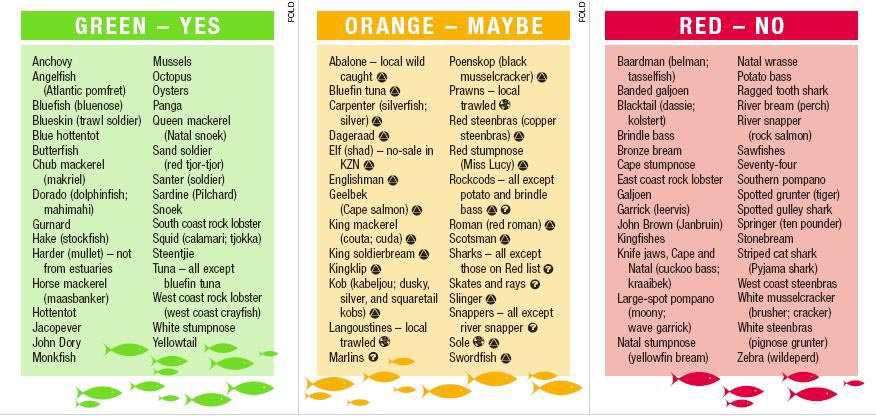Having scuba dived for over 17years I have seen a dramatic reduction in fish life all around our coasts. I got this as an email and felt that it should be read as a status document on the current situation in Johannesburg, South Africa, my home town. This method is the only method to change markets and was sucessful in New York when Swordfish was dangerously threatened. If you buy a current edition of divestyle you will find a fish robot card and article within.
Small downloads
pocket_guide.pdf
Save the whale's friends:
Don Boroughs
Mail&Guardian 02 June 2006 08:45
Selective fishing: Hopefully heightened customer awareness will boost dwindling supplies

Like a bloodhound on the scent of a crime, Kerry Sink enters Portugal Fisheries in Troyeville, Johannesburg, and heads straight for a freezer at the rear of the store. The 33-year-old marine biologist closely scrutinises a package of crayfish tails. "See the scalloped lines on the shell?" she asks.
"Illegal East Coast rock lobsters. In KwaZulu-Natal, I’d have an army of epauletted wildlife officers here in a minute."
Accompanying Sink on a day-long tour of Johannesburg fish shops and restaurants, we discover illegal stock in all but one outlet. On offer throughout the city are shoals of undersized, no-sale-allowed and endangered, but legal, ex-denizens of the deep.
Six years ago, the government declared a "crisis" in linefish stocks and clamped down on fishing permits. But, says Sink, "the line fishery is still in a crisis". Gauteng is a backwater of fisheries law enforcement, and little has been done to staunch the bloodletting from the other end of the food chain.
Until now.
Last week, the Southern African Sustainable Seafood Initiative (Sassi; http://www.panda.org.za/sassi/) launched a campaign to educate consumers and sellers of fish. Its centerpiece is three lists of seafood species: a sustainable green list, an illegal red list and a best-avoided orange list (see website).
Sassi, a partnership between the Department of Environmental Affairs and Tourism, the Endangered Wildlife Trust, wildlife organisation WWF South Africa and other groups, aims to create an army of informed consumers wielding pocket guides distinguishing between green, orange and red.
"People want the information," says Sink, who helped start Sassi. "And we need the consumers to ask: ‘Why the special on orange species? Why are you selling illegally?’"
Sassi is also educating dealers to equip them for a new generation of informed consumers. Training work-shops for fishmongers and restauranteurs have already started in the Western Cape and KwaZulu-Natal, and will begin in Gauteng on July 18.
Our tour of Johannesburg suggested that education is desperately needed. We found carpenter fish labelled as stumpnose, emperor fish identified as grunter and a striped jobfish posing as rock salmon. Ironically, selling rock salmon is illegal.
Tony Diogo, owner of Portugal Fisheries, exemplifies the industry confusion.
Informed that some of his "crayfish tails" are banned East Coast rock lobster, he produces documents authorising him to import three other lobster species.
"I don’t know much about lobster," he admits.
Sink has high hopes for consumer education. "The single biggest effect you have on the health of the oceans is what you eat out of them," she says.
On the orange list of legal, but dodgy, seafood are such favourites as kabeljou, prawns and kingklip. Sink calls kabeljou a "flagship species". Down to 2,3% of its pristine breeding population, the fish "desperately needs a restock", she says.
Sink sifts through the ice in a large bin of small kabeljou at Malvern’s Mediterranean Fish Centre. A kob must grow to nearly a metre in length to reach sexual maturity. "None of the fish in this bin have had a chance to breed," she laments.
At Rio D’Ouro Fisheries in Kenilworth, Sink shudders when she comes upon a plate-size rosy fish in a bin of mixed fish. "Red stumpnose," she says. "It’s like eating a rhino." Indeed, South Africa’s rhino population is in much better shape. Annual catches of red stumpnose on the South Coast collapsed from 757kg per boat in the 1920s to 7kg in the 1990s.
Prawns and langoustines are more plentiful, but for every kilogram of prawns on a plate, three kilos of dead crustaceans — mistakenly trapped by trawling prawn nets — are tossed back into the ocean. About 5 000 sea turtles die in the Mozambican prawn fishery each year.
There is a positive "angle", however. Sink notes that the green list is longer than the orange and red lists. At every outlet on our tour, she found an array of sustainable options, including oysters, angelfish, white stumpnose and yellowtail.
Cape Town chef Justine Drake, of BBC Food Channel fame, scoffs at the idea that fish lovers will suffer if they follow the green list. "Hake has more flavour than kingklip and gurnard is excellent," she says. "There are plenty of great options."
Sink also wants consumers to query how their fish is caught. For instance, line fishing by hand or rod is far less damaging than longline fishing, which has helped put most albatross species on the endangered list. When no one at Morningside’s Codfather restaurant could tell her how their tuna was hooked, she settled for butternut soup.
Her appetite may also have been spoiled by the fillets of illegal spotted grunter at the fish counter. Cod-father owner Mary-Anne Sinovich has seen Sassi’s lists and has stopped buying white steenbras, but had no idea spotted grunter was off-limits. "Often you get a shipment and grunter or something else is mixed in," she says.
Sink had joked that she would eat a proper meal when we found a restaurant with nothing illegal for sale. At our last stop, we visited the Sandton City outlet of The Cape Town Fish Market restaurant chain, where Sink positively identified a red-list river snapper staring at her from behind the counter.
Walking out of the restaurant, she shrugged: "No lunch for Kerry today."